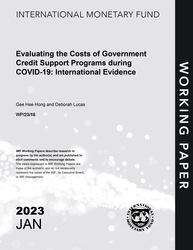
Evaluating the Costs of Government Credit Support Programs during COVID-19: International Evidence
Evaluating the Costs of Government Credit Support Programs during COVID-19: International Evidence
READ MORE...
Volume/Issue:
Volume 2023
Issue 016
Publication date: January 2023
ISBN: 9798400231605
$0.00
Add to Cart by clicking price of the language and format you'd like to purchase
Available Languages and Formats
| English |
Topics covered in this book
This title contains information about the following subjects.
Click on a subject if you would like to see other titles with the same subjects.
Economics- Macroeconomics , Economics / General , credit guarantee programs , fair-value basis , COVID-19 , fiscal risks
Summary
Advanced economies made available more than 5 trillion USD through government-supported credit guarantee and direct loan programs to provide lifelines to firms in the face of the COVID-19 pandemic. Notwithstanding the unprecedented scale of credit made available, an in-depth analysis of the fiscal consequences is missing, and the costs of these programs are not recognized in a transparent way. In this paper, we fill in an important aspect of the fiscal picture by estimating the subsidies that were provided by the largest credit guarantee programs introduced in 2020 in seven advanced economies. We estimate the subsidies on a fair value basis that provides a consistent and comprehensive upfront measure of cost. We explain the logic behind applying a fair value framework in a government context and compare it to alternative approaches. For the programs that we examine, total credit extended totaled 1.7 trillion USD. The subsidy element (cash-equivalent subsidy) is estimated to be 67 percent of loan principal on average (37 percent, excluding the US PPP), with a wide range across programs, from 12 to 100 percent. The variation is explained by differences across programs including eligibility criteria, loan terms, compensation to lenders, and other program design choices.
Copyright © 2010 - 2025
Powered by:
AIDC



